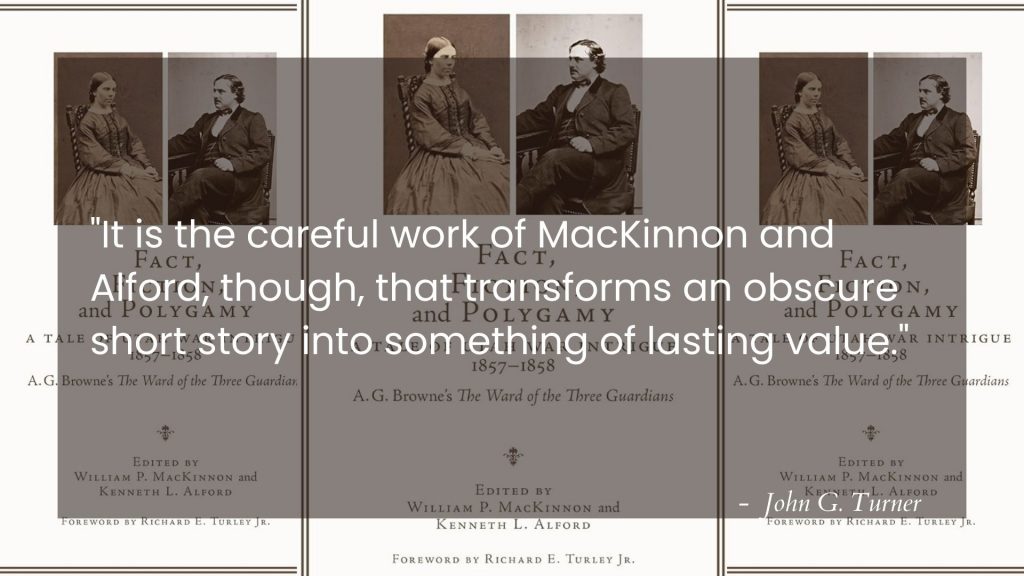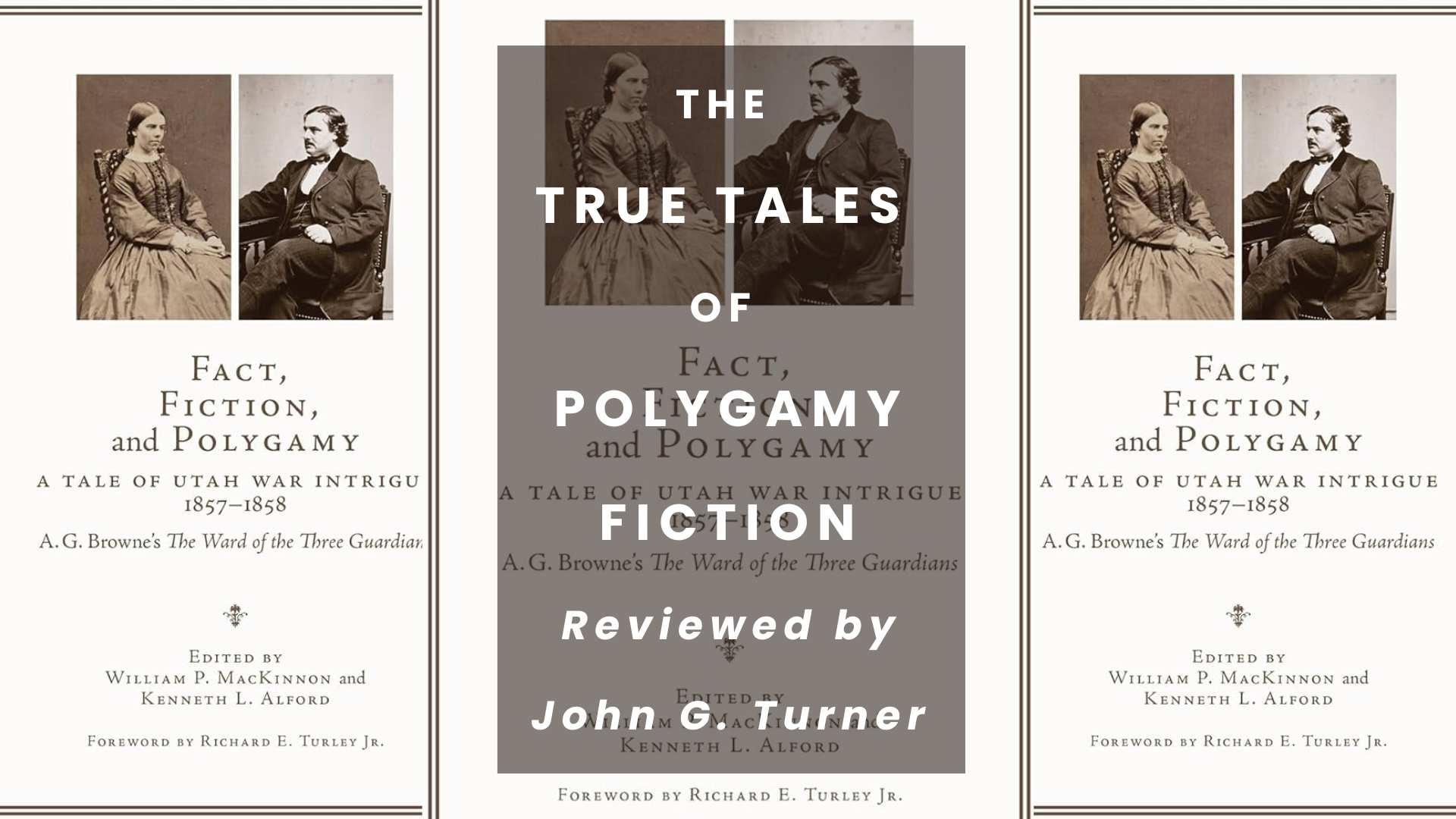Articles/Essays – Volume 57, No. 2
The True Tales of Polygamy Fiction | William A. MacKinnon and Kenneth L. Alford, eds., Fact, Fiction, and Polygamy: A Tale of Utah War Intrigue,1857–1858: A. G. Browne’s The Ward of the Three Guardians
A woman unhappily married to a polygamist. A girl trapped in Utah, separated from her father, likely soon to be sealed to a hoary elder. A gentile-accompanied flight to safety.
Albert G. Browne Jr.’s “The Ward of the Three Guardians,” published in 1877 in the Atlantic Monthly, possesses many of the stock elements of a good late-nineteenth-century story about Utah and the Mormons. Browne, though, based his “lightly fictionalized” (p. 28) tale on actual people and events he observed when he accompanied the US Army to the Utah Territory in 1857. After its 1877 publication in the Atlantic Monthly, however, “Ward” attracted little attention. Now, the indefatigable historians William P. MacKinnon and Kenneth L. Alford have resurrected Browne’s story and excavated its fascinating history.
Albert Browne is a familiar name to students of the Utah War. Based on his firsthand observation of events and interviews with many principals, in 1859 he published an extensive history of the Utah Expedition. MacKinnon and Alford give us the rest of his story, which included anonymous wartime dispatches to both the New York Tribune and Cincinnati’s Enquirer. He also became clerk to Delana R. Eckels, the newly appointed chief justice of Utah’s Supreme Court, who was traveling west with the army.

Henrietta Polydore, the ward in question, is a much more obscure figure, but MacKinnon and Alford have discovered a considerable amount of material about her. In 1852, Henrietta’s mother, along with her parents and several siblings, converted from Catholicism to Mormonism, alienating and enraging the girl’s father, Henry. Two years later, the Latter-day Saint converts abruptly withdrew Henrietta from her boarding school and boarded a steamer for New Orleans. In Utah, Henrietta’s aunt, Jane Mayer, became the fourth wife of Samuel W. Richards, but her mother (also Henrietta) left Utah, returned to England to help more families emigrate, and settled with them in Arkansas. The younger Henrietta Polydore remained ensconced in the Richards household. Meanwhile, Henry Polydore wanted her back, and, after a request from the British Foreign Office, US officials initiated legal proceedings that led to her return to England.
The Henrietta Polydore case caused a stir at the time but had been long forgotten by the time Browne wrote “Ward.” Indeed, she had died several years before its publication. There are scraps of information about her in Browne’s wartime dispatches and in the writings of her relatives, including Christina Rossetti, her cousin and a well-known poet. The fullest account of her life, however, came in Browne’s story, in which he and two officials became the three wards trusted with the task of shepherding her out of Utah.
The heart of Fact, Fiction, and Polygamy is “Ward” itself, which MacKinnon and Alford generously designate a “novella” rather than a short story. No matter. “Ward” is a good read, much better than the many banal and melodramatic novels and stories written about Mormon Utah in the second half of the nineteenth century. For instance, Browne has mountain man Jim Bridger describe Samuel Richards (Sam Peckham in “Ward”) as “not a picture card but about a ten spot” in the church hierarchy (p. 91). The fact that Browne was there gives his narration a decided richness and credibility.
It is the careful work of MacKinnon and Alford, though, that transforms an obscure short story into something of lasting value. Browne divided his story into six sections, which the editors introduce and annotate, and they identify the many pseudonyms that Browne employed (Henrietta Perego rather than Polydore). They have found a host of documents on both sides of the Atlantic that enable them to sift fact from fiction in “Ward.” For instance, Browne depicts Jane Mayer Richards as disillusioned with polygamy and supportive of her niece’s flight from Utah, which MacKinnon and Alford consider “speculation” without evidence (p. 180). There is, however, a good bit of history in “Ward.” For instance, Browne quoted at length from a series of letters pertaining to the case, letters that the editors tracked down from the UK National Archives but have otherwise been unknown.
Fact, Fiction, and Polygamy serves two worthy purposes. Even with the editors’ apparatus, it’s a fun and quick read and a book one could enjoy in a single sitting. At the same time, it’s a window into the actual experiences of a twelve-year-old girl, her scattered relatives, a journalist, and a variety of US officials. As the editors note, “the war involved women and girls as well as the males who were their husbands, lovers, relatives, protectors, and occasional tormenters” (p. 28). MacKinnon and Alford also use the Polydore case to illustrate the war’s “sprawling geographical scope” (p. 29). In this instance, the war very much changed one woman’s life; without the conflict, Henry Polydore, British diplomats, and US officials would have been hard-pressed to locate Henrietta Polydore. And without the efforts of Albert Browne, William MacKinnon, and Kenneth Alford, we would be unlikely to remember her remarkable childhood.
William A. MacKinnon and Kenneth L. Alford, eds. Fact, Fiction, and Polygamy: A Tale of Utah War Intrigue, 1857–1858: A. G. Browne’s The Ward of the Three Guardians. Foreword by Richard E. Turley Jr. Tanner Trust Fund, 2022. 248 pp. Cloth: $24.95. ISBN-10: 1647690692.


 Back to full Issue
Back to full Issue

